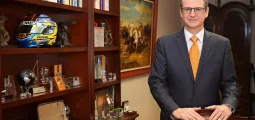Patrik Lundström: Break on Through to the Green Side of Clothing Production…

Renewcell CEO: Patrik Lundström
Every entrepreneur wants to build a business on a breakthrough process; not many have done so. On the back of a breakthrough process, perhaps; but true pioneers are thin on the ground.
We have one for you here, though, all the way from Sweden: meet Patrik Lundström, CEO at Renewcell. Lundström has taken an existing idea — recycling — and given it such a novel spin that an entire industry has taken note.
While recycling is increasingly popular across industries and sectors, Renewcell operates in one that thrives on the new, the fresh, the avant garde: the world of fashion. Well, perhaps a precursor to fashion — but raw materials have to come from somewhere. Lundström has ensured that the “somewhere” is beyond reproach when it comes to sustainability.
Renewcell’s breakthrough process is that rarest of fish, a true world-first: it produces 100 percent recycled fibre pulp, at scale. It receives used clothes and textile production waste with high cellulosic content, such as cotton. After being denuded of zips, buttons and baubles, the raw materials are shredded and chopped into a slurry. Contaminants are separated and filtered-off; the remaining goop is Circulose-branded dissolving pulp, which is formed into sheets. This is forwarded to fibre producers as a replacement for new cotton, oil and even wood.
Circulose fibres are indistinguishable from viscose derived from other sources; the only difference is in the circularity. Brands use them in place of virgin materials to reduce environmental impact. The best part? There’s no compromise in terms of quality.
The patented process tech was developed in conjunction with researchers at Stockholm’s KTH Royal Institute of Technology. For the first five years — it was founded in 2012 — Renewcell was little more than a research project. “In 2017, we started our demonstration plant in Kristinehamn,” Lundström told Fibre2Fashion magazine, “where we produced at industrial scale and launched clothes made with Circulose in stores with global brands.”
Taking things to the next step — to commercial scale, at a modern plant in Sundsvall — is happening this year, with 100 employees already lined-up and ready for action. Maximum production? An impressive 60,000 tonnes per year, if things go according to plan. And there’s no reason to suspect that they won’t.
In the increasingly aware fashion industry, demand for Circulose products is off the hook — and permanent, positive change for relevant industries is a real possibility. Hundreds of thousands of tonnes of used garments that would otherwise go to landfill are now riding on the hips and backs of trendsetters and influencers.
And this, believes the Renewcell CEO, is just the beginning. His firm is partnering with suppliers of post-consumer and post-industrial textile waste to obtain material with a minimum of 95 percent cotton content, compliant with its supplier code of conduct. Contracts for more than 40,000 tonnes of waste have been signed.
Lundström is well qualified for the task, as well as having the nous to spot an opening and create a niche that benefits just about everyone. He has a Masters degree in chemical engineering from KTH Royal Institute of Technology, and an executive MBA from Stockholm School of Economics.
And he’s hands-on, in terms of involvement. He holds, personally and through the company, 49,029 shares and 22,236 warrants that entitle to the subscription of 1,445,340 shares — as well as 49,895 warrants from the latest incentive programme that entitle him to 49,895 shares in the company.
You may have an interest in also reading…
Hands-on, Dedicated to Excellence, Driven by Inclusion and Diversity: Meet the Head of Scottish Friendly
This CEO is fulfilling the aspiration for his mutual to become a leader in the UK insurance sector. Scottish Friendly
Goldin Girl: Putting Women’s Rights on a Level Footing
Claudia Goldin is a champion of economic equality for both genders… Claudia Goldin’s name evokes an unshakable commitment to increasing
Jenny Just: The Deck Should Be Stacked — with Tech
US entrepreneur and fintech disruptor Jenny Just believes that girls should be taught to play poker. It’s a game that
















































































